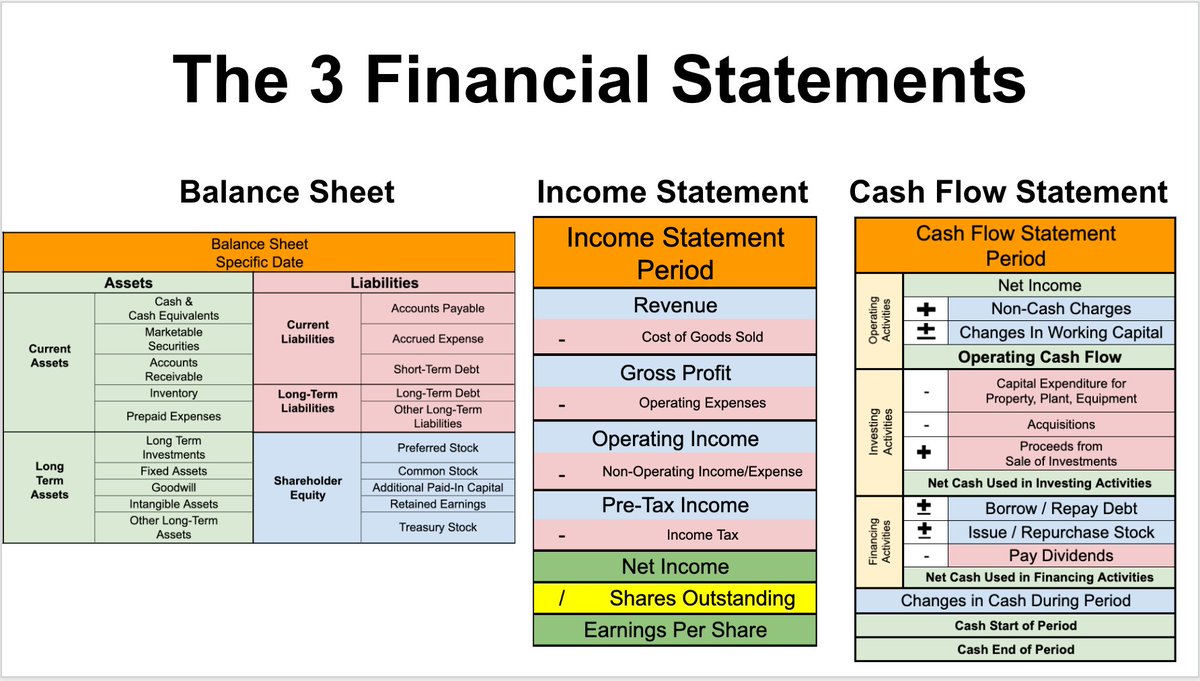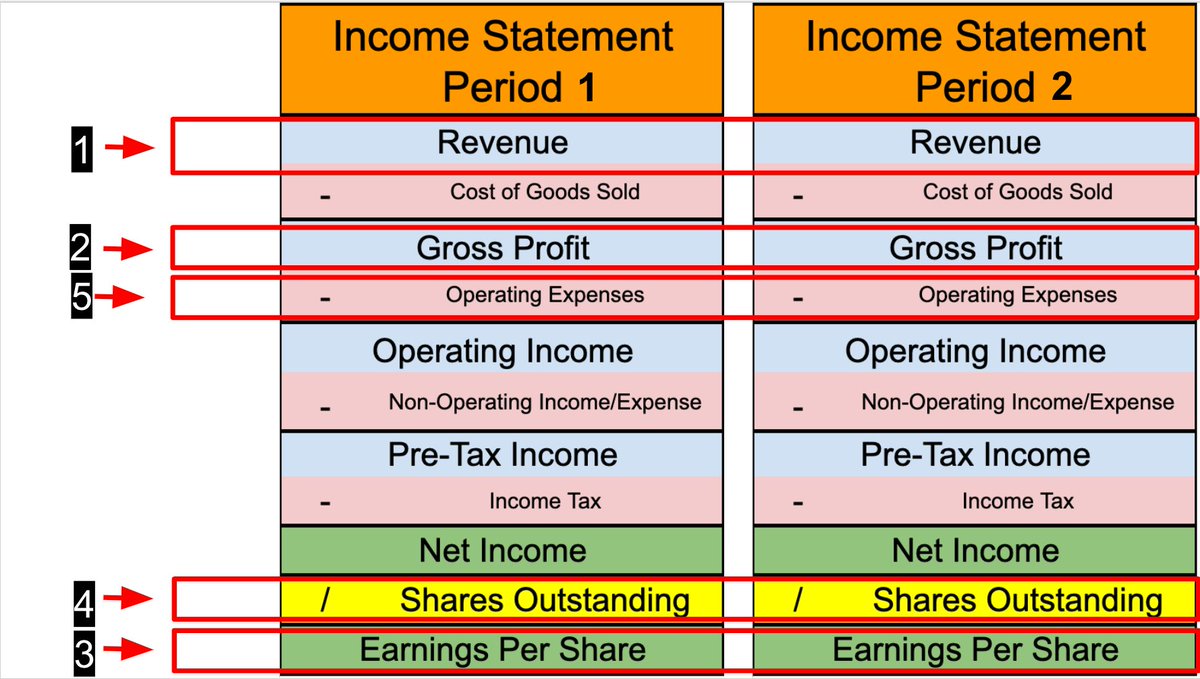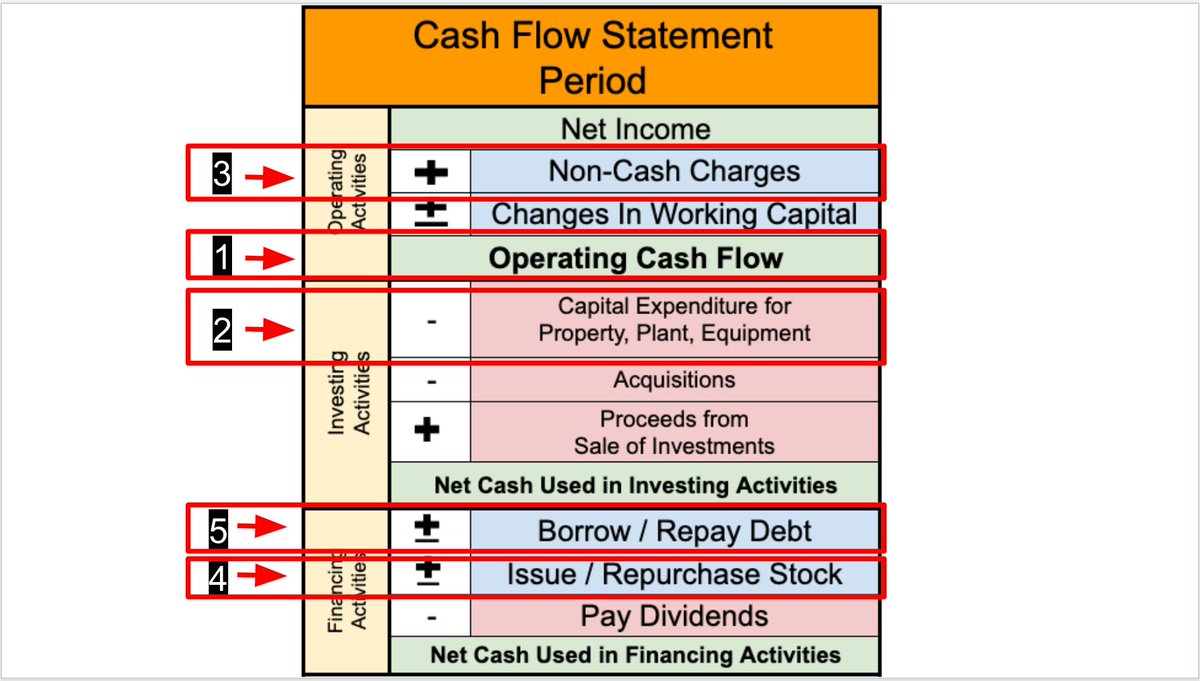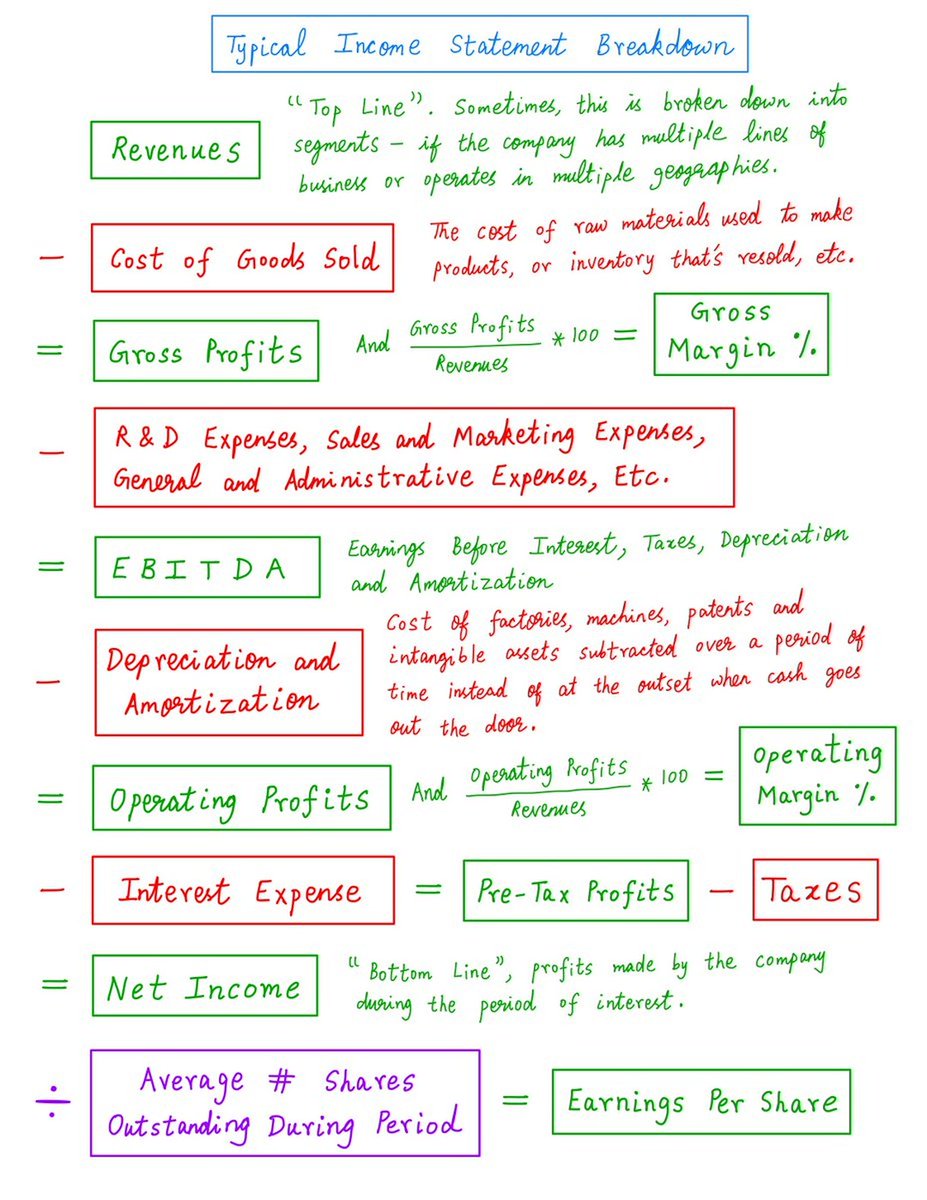Every company has 3 financial statements.
Each answers a unique question:
1. Balance Sheet: What’s your net worth?
2. Income Statement: Are you profitable?
3. Cash Flow Statement: Are you generating cash?
Each answers a unique question:
1. Balance Sheet: What’s your net worth?
2. Income Statement: Are you profitable?
3. Cash Flow Statement: Are you generating cash?

The financial statements are interrelated.
Each views a company’s financials from a different angle.
When combined, they provide a more complete view of a company’s true financial position.
Each views a company’s financials from a different angle.
When combined, they provide a more complete view of a company’s true financial position.

1B: What I focus on first:
1⃣ Cash & Equivalents: How much?
2⃣ Debt: How much vs. cash?
3⃣ Goodwill: How much?
4⃣ Retained Earnings (+ T.S.): Positive?
5⃣ Receivables & Inventory: How much?
1⃣ Cash & Equivalents: How much?
2⃣ Debt: How much vs. cash?
3⃣ Goodwill: How much?
4⃣ Retained Earnings (+ T.S.): Positive?
5⃣ Receivables & Inventory: How much?

1C: Best Possible Answers
1⃣Cash & Equivalents: More than debt
2⃣Short & Long-Debt: None
3⃣Goodwill: Zero
4⃣Retained Earnings (+ T.S.): Positive
5⃣ Receivables & Inventory: None
1⃣Cash & Equivalents: More than debt
2⃣Short & Long-Debt: None
3⃣Goodwill: Zero
4⃣Retained Earnings (+ T.S.): Positive
5⃣ Receivables & Inventory: None
2A: The Income Statement
This tells you if a company is “profitable” or not during a period of time
Layout:
This tells you if a company is “profitable” or not during a period of time
Layout:

2B: I look at 2 income statements with comparable periods.
What I focus on first:
1⃣Revenue: Up or down?
2⃣Gross Profit: Up or down?
3⃣EPS (Diluted): Positive or negative?
4⃣Shares Outstanding: Up or down?
5⃣Operating Expenses: Up or down?
What I focus on first:
1⃣Revenue: Up or down?
2⃣Gross Profit: Up or down?
3⃣EPS (Diluted): Positive or negative?
4⃣Shares Outstanding: Up or down?
5⃣Operating Expenses: Up or down?

2C: Best Possible Answers
1⃣Revenue: Up 30%+
2⃣Gross Profit: Up 30%+
3⃣EPS: Up 30%+
4⃣Shares Outstanding: Down 4%+
5⃣Operating Expenses: Stable
1⃣Revenue: Up 30%+
2⃣Gross Profit: Up 30%+
3⃣EPS: Up 30%+
4⃣Shares Outstanding: Down 4%+
5⃣Operating Expenses: Stable
3A: The Cash Flow Statement
This tells you how cash moves in and out of a business over a period of time.
Layout:
This tells you how cash moves in and out of a business over a period of time.
Layout:

3B: What I focus on first:
1⃣OCF: Positive or negative?
2⃣CapEx: More or less than OCF?
3⃣NCC: Any big numbers? S.B.C.?
4⃣Stock: Issuance or buybacks?
5⃣Debt: Borrow or repay?
1⃣OCF: Positive or negative?
2⃣CapEx: More or less than OCF?
3⃣NCC: Any big numbers? S.B.C.?
4⃣Stock: Issuance or buybacks?
5⃣Debt: Borrow or repay?

3C: Best possible answers
1⃣ OCF: Positive (+ Growing)
2⃣CapEx: Much less than OCF
3⃣NCC: Nothing noteworthy + Low SBC
4⃣Stock: Buybacks ✅
5⃣Debt: Repayment✅
1⃣ OCF: Positive (+ Growing)
2⃣CapEx: Much less than OCF
3⃣NCC: Nothing noteworthy + Low SBC
4⃣Stock: Buybacks ✅
5⃣Debt: Repayment✅
I’d never make an investment decision without MUCH more analysis than this.
Accounting (and investing) is FILLED with nuance
Still, with <1 minute of analysis per financial statement, you can quickly identify a company's strengths + weaknesses
Accounting (and investing) is FILLED with nuance
Still, with <1 minute of analysis per financial statement, you can quickly identify a company's strengths + weaknesses
If you invest, you MUST learn accounting
That's why @Brian_Stoffel_ and I created a course that teaches accounting in plain English
Registration closes TONIGHT (9/18) at 11:59 PM EDT!
Interested? DM me for a special coupon code.
maven.com/brian-feroldi/…
That's why @Brian_Stoffel_ and I created a course that teaches accounting in plain English
Registration closes TONIGHT (9/18) at 11:59 PM EDT!
Interested? DM me for a special coupon code.
maven.com/brian-feroldi/…
Prefer to keep learning for free?
Read this thread I wrote about the cash flow statement next:
Read this thread I wrote about the cash flow statement next:
https://twitter.com/BrianFeroldi/status/1568936832439664641?s=20&t=b_kaBtytTPtc7kMfM7fRUg
• • •
Missing some Tweet in this thread? You can try to
force a refresh























